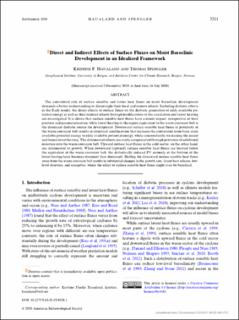| dc.contributor.author | Haualand, Kristine Flacké | |
| dc.contributor.author | Spengler, Thomas | |
| dc.date.accessioned | 2021-06-07T09:34:09Z | |
| dc.date.available | 2021-06-07T09:34:09Z | |
| dc.date.created | 2020-08-17T11:10:10Z | |
| dc.date.issued | 2020-09 | |
| dc.identifier.issn | 0022-4928 | |
| dc.identifier.uri | https://hdl.handle.net/11250/2758134 | |
| dc.description.abstract | The convoluted role of surface sensible and latent heat fluxes on moist baroclinic development demands a better understanding to disentangle their local and remote effects. Including diabatic effects in the Eady model, the direct effects of surface fluxes on the diabatic generation of eddy available potential energy as well as their indirect effects through modifications of the circulation and latent heating are investigated. It is shown that surface sensible heat fluxes have a minor impact, irrespective of their position and parameterization, while latent heating in the region equivalent to the warm conveyor belt is the dominant diabatic source for development. Downward surface sensible heat fluxes in proximity of the warm conveyor belt results in structural modifications that increase the conversion from basic-state available potential energy to eddy available potential energy, while concomitantly weakening the ascent and hence latent heating. The detrimental effects are easily compensated through provision of additional moisture into the warm conveyor belt. Upward surface heat fluxes in the cold sector, on the other hand, are detrimental to growth. When downward (upward) surface sensible heat fluxes are located below the equivalent of the warm conveyor belt, the diabatically induced PV anomaly at the bottom of the latent heating layer becomes dominant (less dominant). Shifting the downward surface sensible heat fluxes away from the warm conveyor belt results in substantial changes in the growth rate, latent heat release, low-level structure, and energetics, where the effect of surface sensible heat fluxes might even be beneficial. | en_US |
| dc.language.iso | eng | en_US |
| dc.publisher | American Meteorological Society | en_US |
| dc.rights | Navngivelse 4.0 Internasjonal | * |
| dc.rights.uri | http://creativecommons.org/licenses/by/4.0/deed.no | * |
| dc.title | Direct and Indirect Effects of Surface Fluxes on Moist Baroclinic Development in an Idealized Framework | en_US |
| dc.type | Journal article | en_US |
| dc.type | Peer reviewed | en_US |
| dc.description.version | publishedVersion | en_US |
| dc.rights.holder | Copyright 2020 American Meteorological Society | en_US |
| cristin.ispublished | true | |
| cristin.fulltext | original | |
| cristin.qualitycode | 2 | |
| dc.identifier.doi | 10.1175/JAS-D-19-0328.1 | |
| dc.identifier.cristin | 1823539 | |
| dc.source.journal | Journal of the Atmospheric Sciences | en_US |
| dc.source.pagenumber | 3211–3225 | en_US |
| dc.relation.project | Norges forskningsråd: 262220 | en_US |
| dc.identifier.citation | Journal of the Atmospheric Sciences. 2020, 77 (9), 3211–3225. | en_US |
| dc.source.volume | 77 | en_US |
| dc.source.issue | 9 | en_US |

